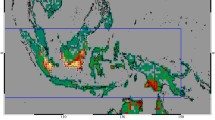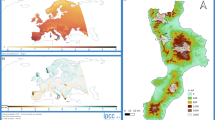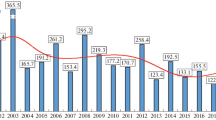Abstract
The emissions from fires in the boreal zone of northern Eurasia significantly contribute to the global emissions of greenhouse gases, their precursors, and aerosols. These emissions are an important component of the global carbon balance, and they significantly affect both seasonal and long-term variations in the chemical composition and radiation properties of the atmosphere on both regional and global scales. The atmospheric emissions of carbon monoxide (CO) from biomass burning have systematically been estimated for the entire territory of northern Eurasia over the period of 2000–2008 on the basis of satellite (MODIS MCD45A1) data on burned vegetation and the Seiler-Crutzen emission model with consideration for both regional and seasonal features. On the whole, for Russia, the annual emissions of CO from biomass burning ranged from 10.6 to 88.2 Mt/y over the indicated period. Depending on fire activity, the atmospheric emissions of CO from natural fires and agricultural work may yield from 25 to 200% of the total technogenic emissions according to the EDGAR-2000 model. In this case, the dominant contribution is made by boreal forest fires (8–57 Mt/y), whose portion amounts to 63–76% of the total emissions from biomass burning. This relatively short observational series does not allow one to reliably estimate long-term variations; however, on the whole, a stable increase in burned areas has been observed in forest, steppe, and agricultural regions over the last decade. Our analysis suggests significant spatial and seasonal variations in the large-scale fields of fire emissions, which are determined by the physical, geographic, and climatic features of individual regions. The calculated fields of emissions can be used in transport-chemical models, studies of the regional transport and quality of air, and climate models.
Similar content being viewed by others
References
J. H. Seinfeld and S. N. Pandis, Atmospheric Chemistry and Physics (Wiley, New York, 1998).
E. S. Kasischke, E. P. Hyre, P. C. Novelli, et al., Influences of Boreal Fire Emissions on Northern Hemisphere Atmospheric Carbon and Carbon Monoxide, Global Biogeoch. Cycles 19(1), GB1012.1–GB1012.16, doi: 10.1029/2004GB002300 (2005).
M. Galanter, H. Levy II, and G. R. Carmichae, “Impacts of Biomass Burning on Tropospheric CO, NOx, and O3,” J. Geophys. Res. 105(D5), 6633–6653 (2000).
M. O. Andreae and P. Merlet, “Emission of Trace Gases and Aerosols from Biomass Burning,” Global Biogeochem. Cycles 15(4), 955–966 (2001).
W. R. Cofer III, E. L. Winstead, B. J. Stocks, et al., “Crown Fire Emissions of CO2, CO, H2, CH4, and TNMHC from a Dense Jack Pine Boreal Forest Fire,” Geophys. Rev. Lett. 25(21), 3919–3922 (1998).
A. A. Kiselev and I. L. Karol, “Model Estimations of the Effect of Siberian Strong Fires on Atmospheric Composition and Regional Climate During 2002–2003 Warm Periods,” Simulation and Assessment of Chemical Processes in a Multiphase Environment, Ed. by I. Barnes and M. M. Kharytonov (2008), pp. 357–362.
C. Whitlock, “Forests, Fires and Climate,” Nature 432(7013), 28–29 (2004).
D. P. Edwards, L. K. Emmons, D. A. Hauglustaine, et al., “Observations of Carbon Monoxide and Aerosols from the Terra Satellite: Northern Hemisphere Variability,” J. Geophys. Res. 109(D24202) doi: 10.1029/2004JD004727 (2004).
D. J. Jacob, J. A. Logan, and P. P. Murti, “Effect of Rising Asian Emissions on Surface Ozone in the United States,” Geophys. Rev. Lett. 26(14), 2175–2178 (1999).
P. J. Crutzen and M. O. Andreae, “Biomass Burning in the Tropics: Impact on Atmospheric Chemistry and Biogeochemical Cycles,” Science 250(4988), 1669–1678 (1990).
W. M. Hao, M. H. Liu, and P. J. Crutzen, Estimates of annual and regional releases of CO2 and other trace gases to the atmosphere from fires in the tropics, based on the FAO statistics for the period 1975–1980, in Fire in the Tropical Biota, Ecological Studies. 84, Ed. by J. G. Goldammer (Springer, Berlin, 1990), pp. 440–462.
C. Wiedinmyer, B. Quayle, C. Geron, et al., “Estimating Emissions from Fires in North America for Air Quality Modeling,” Atmos. Envir 40(19), 3419–3432 (2006).
S. G. Conard and G. A. Ivanova, “Wildfire in Russian Boreal Forests—Potential Impacts of Fire Regime Characteristics on Emissions and Global Carbon Balance Estimates,” Envir. Pollut. 98(3), 305–313 (1997).
Russian Forests. Federal Forest Service of Russia, All-Russian Research and Information Centre for Forest Resources, Ed. by M. F. Nyejlukto, (Kolyev, Moscow, 1994), p. 15.
N. M. Tchebakova, R. A. Monserud, and R. Leemans, “A Siberian Vegetation Model Based on Climatic Parameters,” Can. J. Forest Res. 24(8), 1597–1607 (1994).
B. Bolin, “How Much Carbon Dioxide Will Remain in the Atmosphere?,” in The Greenhouse Effect, Climatic Change, and Ecosystems, Ed. by B. Bolin, B. Doos, J. Jager, et al., SCOPE 29 (Wiley, London, 1986), pp. 93–155.
P. J. Crutzen, L. E. Heidt, J. P. Krasnec, et al., “Biomass Burning As a Source of Atmospheric Gases CO, H2, N2O, NO, CH3Cl, and COS,” Nature 282(5736), 253–356 (1979).
G. B. Bonan, “Atmosphere-Biosphere Exchange of Carbon Dioxide in Boreal Forests,” J. Geophys. Res. 96(D4), 7301–7312 (1991).
M. D. Flanniga, Y. Bergeron, O. Engelmark, et al., “Future Wildfire in Circumboreal Forests in Relation to Global Warming,” J. Veget. Sci. 9(4), 469–476 (1998).
B. J. Stocks, M. A. Fosberg, T. J. Lynham, et al., “Climate Change and Forest Fire Potential in Russian and Canadian Boreal Forests,” Clim. Change 38(1), 1–13 (1998).
S. G. Conard, A. I. Sukhinin, B. J. Stocks, et al., “Determining Effects of Area Burned and Fire Severity on Carbon Cycling and Emissions in Siberia,” Climatic Change 55(1–2), 197–211 (2002).
D. C. Lavoue, C. Liousse, H. Cachier, et al., “Modelling of Carbonaceous Particles Emitted by Boreal and Temperate Wildfires at Northern Latitudes,” J. Geophys. Res. 105(D22), 26871–26890 (2000).
K. P. Kutsenogii, G. A. Ivanova, T. V. Churkina, et al., “Multielemental Composition of Aerosols Formed during Fires in Boreal Forests and during Firing of Forest Materials,” in Proceedings of XIII Russian Conference on the Use of Synchrotropic Radiation, Ed. by V. B. Baryshev (Novosibirsk, 2000), pp. 249–250.
Yu. N. Samsonov, K. P. Kutsenogii, V. I. Makarov, et al., “Aerosol Emission during Forest Fires in Boreal Forests of Siberia,” in Aerosols in Siberia (Sib. Otd. Ross. Akad. Nauk, Novosibirsk, 2006), pp. 260–281 [in Russian].
K. Kita, M. Fujiwara, and S. Kawakami, “Total Ozone Increases Associated with Forest Fires over the Indonesian Region and Its Relation to the El Niño-Southern Oscillation,” Atmos. Env. 34(17), 2681–2690 (2000).
H. Tanimoto, Y. Kajii, J. Hirokawa, et al., “The Atmospheric Impact of Boreal Forest Fires in Far Eastern Siberia on the Seasonal Variation of Carbon Monoxide: Observations at Rishiri, a Northern Remote Island in Japan,” Geophys. Rev. Lett. 27(24), 4073–4076 (2000).
H. Tanimoto, H. Furutani, S. Kato, et al., “Seasonal Cycles of Ozone and Oxidized Nitrogen Species in Northeast Asia, 1, Impact of Regional Climatology and Photochemistry Observed during RISOTTO 1999–2000,” J. Geophys. Res. 107(4747), doi: 10.1029/2001JD001496 (2002).
H. Tanimoto, K. Matsumoto, and M. Uematsu, “Ozone-CO Correlations in Siberian Wildfire Plumes Observed at Rishiri Island,” SOLA 4, 065–068, doi: 10.2151/sola.2008-017 (2008).
D. A. Jaffe, R. E. Honrath, L. Zhang, et al., “Measurements of NO, NOy, CO and O3 and Estimation of the Ozone Production Rate at Oki Island, Japan, during PEM-West,” J. Geophys. Res. 101(D1), 2037–2048 (1996).
G. Wotawa and M. Trainer, “The Influence of Canadian Forest Fires on Pollutant Concentrations in the United States,” Science 288(5464), 324–328 (2000).
N. Spichtinger, M. Wenig, P. James, et al., “Satellite Detection of a Continental-Scale Plume of Nitrogen Oxides from Boreal Forest Fires,” Geophys. Rev. Lett. 28(24), 4579–4582 (2001).
N. Spichtinger, R. Damoah, S. Eckhardt, et al., “Boreal Forest Fires in 1997 and 1998: a Seasonal Comparison Using Transport Model Simulations and Measurement Data,” Atmos. Chem. Phys. 4(7), 1857–1868 (2004).
I. T. Bertschi, D. A. Jaffe, L. Jaegle, et al., “B. PHOBEA/ITCT 2002 Airborne Observations of Transpacific Transport of Ozone, CO, Volatile Organic Compounds, and Aerosols To the Northeast Pacific: Impacts of Asian Anthropogenic and Siberian Boreal Fire Emissions,” J. Geophys. Res. 109(D23S12), doi: 10.1029/2003JD004328 (2004).
C. Forster, U. Wandinger, G. Wotawa, et al., “Transport of Boreal Forest Fire Emissions from Canada to Europe,” J. Geophys. Res. 106(D19), 22887–22906 (2001).
E. N. Valendik, Large-Scale Forest Fires, Ed. by E. N. Valendik, P. M. Matveev, and M. A. Sofronov (Nauka, Moscow, 1979) [in Russian].
M. Fromm and R. Servranckx, “Transport of Forest Fire Smoke above the Tropopause by Supercell Convection,” Geophys. Rev. Lett. 1542(10), doi: 10.1029/2002GL016820 (2003).
D. Jaffe, et al., “Transport of Asian Air Pollution to North America,” Geophys. Rev. Lett. 26(6), 711–714 (1999).
D. Jaffe, I. Bertschi, L. Jaeglé, et al., “Long-Range Transport of Siberian Biomass Burning Emissions and Impact on Surface Ozone in Western North America,” Geophys. Rev. Lett. 31(L16106) (2004).
Jr. D. R. Cahoon, B. J. Stocks, J. S. Levine, et al., “Satellite Analysis of the Severe 1987 Forest Fires in Northern China and Southeastern Siberia,” J. Geophys. Res. 99(D9), 18627–18638 (1994).
M. Fromm, J. Alfred, K. Hoppel, et al., “Observations of Boreal Forest Fire Smoke in the Stratosphere by POAM III, SAGE II, and Lidar in 1998,” Geophys. Rev. Lett. 27(9), 1407–1410 (2000).
N. C. Hsu, J. R. Herman, P. K. Bhartia, et al., “Detection of Biomass Burning Smoke from TOMS Measurements,” Geophys. Rev. Lett. 23(7), 745–748 (1996).
I. T. Bertschi and D. A. Jaffe, “Long-Range Transport of Ozone, Carbon Monoxide, and Aerosols to the NE Pacific Troposphere during the Summer of 2003: Observations of Smoke Plumes from Asian Boreal Fires,” J. Geophys. Res. 110(D05303), doi: 10.1029/2004JD005135 (2005).
J.-D. Paris, A. Stohl, P. Ciais, et al., “Source-Receptor Relationships for Airborne Measurements of CO2, CO, and O3 above Siberia: A Cluster-Based Approach,” Atmos. Chem. Phys. Discuss. 9(2), 6207–6245 (2009).
S. Eckhardt, A. Stohl, S. Beirle, et al., “The North Atlantic Oscillation Controls Air Pollution Transport to the Arctic,” Atmos. Chem. Phys. 3(5), 1769–1778 (2003).
R. Treffeisen, P. Turnved, J. Ström, et al., “Arctic Smoke—Aerosol Characteristics during a Record Air Pollution Event in the European Arctic and Its Radiative Impact,” Atmos. Chem. Phys. Discuss. 7(1), 2275–2324 (2007).
A. Stohl, T. Berg, J. F. Burkhart, et al., “Arctic Smoke—Record High Air Pollution Levels in the European Arctic due to Agricultural Fires in Eastern Europe,” Atmos. Chem. Phys. Discuss. 6(2), 9655–9722 (2006).
K. Chance, P. I. Palmer, R. J. D. Spurr, et al., “Satellite Observations of Formaldehyde over North America from GOM,” Geophys. Rev. Lett. 27(21), 3461–3464 (2000).
P. C. Novelli, K. A. Masarie, P. M. Lang, et al., “Reanalysis of Tropospheric CO Trends: Effects of the 1997–1998 Wildfires,” J. Geophys. Res. 108(D15), doi: 10.1029/2002JD003031 (2003).
G. Wotawa, P. C. Novelli, M. Trainer, et al., “Inter-Annual Variability of Summertime CO Concentrations in the Northern Hemisphere Explained by Boreal Forest Fires in North America and Russia,” Geophys. Rev. Lett. 28(24), 4575–4578 (2001).
L. N. Yurganov, P. Duchatelet, A. V. Dzhola, et al., “A Quantitative Assessment of the 1998 Carbon Monoxide Emission Anomaly in the Northern Hemisphere Based on Total Column and Surface Concentration Measurements,” J. Geophys. Res. 109(D15305), doi: 10.1029/2004JD004559 (2004).
P. Nedelec, V. Thouret, J. Brioude, et al., “Extreme CO Concentrations in the Upper Troposphere over Northeast Asia in June 2003 from the in Situ MOZAIC Aircraft Data,” Geophys. Rev. Lett. 32(L14807), doi: 10.1029/2005GL023141 (2005).
TROICA Mobile Observatory and the Monitoring of the Atmospheric Composition over Russia, Ed. by N. F. Elansky (Obukhov Institute of Atmospheric Physics, Moscow, 2006), p. 44.
MSD45A1 MODIS Level 3 Monthly Tiled 500 m Burned Area Product, http://modis-fire.umd.edu/MCD45A1.asp.
D. P. Roy, L. Boschetti, C. O. Justice, et al., “The Collection 5 MODIS Burned Area Product—Global Evaluation by Comparison with the MODIS Active Fire Product,” Rem. Sens. Envir 112(9), 3690–3707 (2008).
S. A. Bartalev, V. A. Egorov, E. A. Loupian, et al., “Multi-Year Circumpolar Assessment of the Area Burnt in Boreal Ecosystems using SPOT-VEGETATION,” Int. J. Remote Sensing 28(6), 1397–1404, doi: 10.1080/01431160600840978 (2007).
L. Giglio, G. R. van der Werf, J. T. Randerson, et al., “Global Estimation of Burned Area using MODIS Active Fire Observations,” Atmos. Chem. Phys. 6(4), 957–974 (2006).
E. S. Kasischke and L. P. Bruhwiler, “Emissions of Carbon Dioxide, Carbon Monoxide, and Methane from Boreal Forest Fires in 1998,” J. Geophys. Res. 108(D1), 8146, doi: 10.1029/2001JD000461 (2003).
A. J. Soja, W. R. Cofer, H. H. Shugart, et al., “Estimating Fire Emissions and Disparities in Boreal Siberia (1998–2002),” J. Geophys. Res. 109, doi: 10.1029/2004JD004570 (2004).
J. J. Hoelzemann, M. G. Schultz, G. P. Brasseur, et al., “Global Wildland Fire Emission Model (GWEM): Evaluating the Use of Global Area Burnt Satellite Data,” J. Geophys. Res. 109, doi: 10.1029/2003JD003666 (2004).
Y. H. Zhang, M. J. Wooster, O. Tutubalina, et al., “Monthly Burned Area and Forest Fire Carbon Emission Estimates for the Russian Federation from SPOT VGT,” Rem. Sens. Envir., 87(1), 1–15 (2003).
W. Seiler and P. J. Crutzen, “Estimates of Gross and Net Fluxes of Carbon Between the Biosphere and Atmosphere from Biomass Burning,” Climate Change 2, 207–247 (1980).
[GLOBLC] University of Maryland Global Land Cover Classifications: http://islscp2.sesda.com/ISLSCP2-1/data/vegetation/umd-landcover-xdeg/0-umd-landcoverreadme.txt
M. Hansen, R. DeFries, J. R. G. Townshend, et al., “Global Land Cover Classification at 1 Km Resolution Using a Classification Tree Approach,” Intern. J. Rem. Sensing 21(6–7), 1331–1364 (2000).
S. P. Khromov and M. A. Petrosyants, Meteorology and Hydrology (Mosk. Gos. Univ., Moscow, 2001) [in Russian].
I. G. Goldammer, A. I. Sukhinin, and I. Chisar, Management of Forest Fires at Ecoregional Level (Moscow, 2004) [in Russian].
G. A. Ivanova and V. A. Ivanov, “Fire Regimes in Siberian Forests,” International Forest Fires News (IFFN), No. 32, 67–69 (2005).
Analysis of Climate in the Northern Hemisphere, http://hmc.hydromet.ru/climate/climate.html
H. Balzter, F. Gerard, G. Weedon, et al., “Climate, Vegetation Phenology and Forest Fires in Siberia,” in 2008 IEEE International Geoscience and Remote Sensing Symposium (Institute for Electrical and Electronics Engineers, Boston, 2008), pp. 6–11.
Carbon in Ecosystems of Forest and Bogs of Russia, Ed. by V. A. Alekseev and R. A. Berdsi (Sukachev Forest Institute, Krasnoyarsk, 1994), p. 173 [in Russian].
V. Alexeyev, R. A. Birdsey, V. Stakanov, et al., “Carbon in Vegetation of Russian Forests: Methods to Estimate Storage and Geographical Distribution,” Water Air Soil Pollut. 82(1–2), 271–282 (1995).
A. S. Isaev, G. N. Korovin, S. A. Bartalev, et al., “Using Remote Sensing to Assess Russian Forest Fire Carbon Emissions,” Climatic Change 55(1–2), 235–249 (2002).
R. E. Wolfe, M. Nishihama, A. J. Fleig, et al., “Achieving Sub-Pixel Geolocation Accuracy in Support of MODIS Land Science,” Rem. Sens. Environ. 83(1), 31–49 (2002).
D. P. Roy, Y. Jin, P. E. Lewis, et al., “Prototyping a Global Algorithm for Systematic Fire-Affecting Area Mapping using MODIS Time Series Data,” Rem. Sens. Environ. 97(2), 137–162 (2005).
N. H. F. French, P. Goovaerts, and E. S. Kasischke, “Uncertainty in Estimating Carbon Emissions from Boreal Forest Fires,” J. Geophys. Res. 109(D14S08) (2004).
R. K. Dixon and O. N. Krankina, “Forest Fires in Russia: Carbon Dioxide Emissions to the Atmosphere,” Can. J. For. Res. 23(4), 700–705 (1993).
A. Z. Shvidenko and S. Nilsson, “Fire and the Carbon Budget of Russian Forests,” in Ecological Studies 138—Fire, Climate Change, and Carbon Cycling in the Boreal Forests, Ed. by E. Kasischke and B. Stocks (Springer, New York, 2000), pp. 289–311.
Y. Kajii, S. Kato, D. G. Streets, et al., “Boreal Forest Fires in Siberia in 1998: Estimation of Area Burned and Emissions of Pollutants by Advanced Very High Resolution Radiometer Satellite Data,” J. Geophys. Res. 107(D24), 4745 (2002).
Author information
Authors and Affiliations
Corresponding author
Additional information
Original Russian Text © A.V. Vivchar, K.B. Moiseenko, N.V. Pankratova, 2010, published in Izvestiya AN. Fizika Atmosfery i Okeana, 2010, Vol. 46, No. 3, pp. 307–320.
Rights and permissions
About this article
Cite this article
Vivchar, A.V., Moiseenko, K.B. & Pankratova, N.V. Estimates of carbon monoxide emissions from wildfires in northern Eurasia for airquality assessment and climate modeling. Izv. Atmos. Ocean. Phys. 46, 281–293 (2010). https://doi.org/10.1134/S0001433810030023
Received:
Accepted:
Published:
Issue Date:
DOI: https://doi.org/10.1134/S0001433810030023




